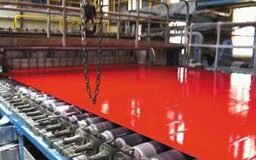RISI’s North American CEO of the Year
 Meet Doyle Simons, President and CEO, Weyerhaeuser
Meet Doyle Simons, President and CEO, Weyerhaeuser
Doyle Simons counts on efficiency and work traits
for a bigger Weyco REIT as the firm exits pulp and paper.
GREG RUDDER
When Doyle Simons took over at Weyerhaeuser, described by one insider as a “stodgy” company, he came to dramatically change things, traveling from his small-town Texas and Temple-Inland executive roots to the Pacific Northwest.
 Right before he started, the company acquired Longview Timber for US$2.65 billion in July 2013. Two-and-a-half years later, Simons significantly expanded Weyerhaeuser with a US$8.4 billion merger with Plum Creek Timber, and is finishing the company’s full separation from the pulp and paper business after an 85-year run.
Right before he started, the company acquired Longview Timber for US$2.65 billion in July 2013. Two-and-a-half years later, Simons significantly expanded Weyerhaeuser with a US$8.4 billion merger with Plum Creek Timber, and is finishing the company’s full separation from the pulp and paper business after an 85-year run.
The Plum Creek acquisition established Weyerhaeuser as the largest US timberland owner and a US$25-30 billion REIT. Weyerhaeuser’s final pulp and paper assets are to be sold in deals with International Paper (IP) for US$2.2 billion and with Nippon Paper for US$285 million. (At press time, the Nippon Paper deal had been completed; the IP deal was still pending.) A third and final paper business, Norpac publication papers in Longview, WA, is also slated for sale.
Chiefly due to the Plum Creek acquisition, Wall Street analysts selected Simons as the RISI 2016 North America CEO of the Year. He was honored in October at RISI’s 31st annual Forest Products Conference in San Diego. Simons is the first industry CEO from two different companies to win RISI’s top executive honor; he won the 2009 award while at Temple-Inland. His progress at Weyerhaeuser is also unique, according to analysts and insiders.
SIMONS ‘ABOUT WINNING’
His changes are both far-reaching and simple. He wants Weyerhaeuser to be a “truly great” company. He used the term more than once in the company’s latest annual report, identifying this seemingly indefinable goal by emphasizing workers should “act with urgency, be accountable, be courageous, keep it simple, and be innovative.”
Asked about the “truly great” claim, and using a sports analogy about the importance of consistent habits and routine to be successful, Simons said in a nearly hour-long interview with PPI Pulp & Paper Week: “It’s ultimately about  winning, and I’m a big believer in people liking to win.”
winning, and I’m a big believer in people liking to win.”
During his first 50 days as CEO in 2013, Simons zig-zagged across the country, visiting 50 company sites. At each location, he led a town hall meeting, toured the property, and spoke one-on-one with workers. He found what he called “really good assets” and “really good people.” A new company official said of the 52-year-old Simons: “He believes the way to stay laser-beam focused on the task at hand is by keeping things simple.”
“No doubt, he’s a transformational leader, which is what they wanted and needed,” a contact said. “Simons is progressive and aggressive.”
Buckingham Research analyst Mark Weintraub, a longtime industry analyst, said Simons is carrying out a “bold repositioning of the company while at the same time building on its core competency as the pre-eminent private timberland owner in the world.”
In those first 50 days, Simons said he “learned about what we do well… and what we need to do to make Weyerhaeuser a truly great company.”
Simons recently mentioned examples of operational improvements, such as improving reliability and lowering costs at a sawmill to getting the right log to the right customer effectively and efficiently. He likes a simple vision: “I’d much rather say one thing 500 times than say 500 things one time,” he says.
COLUMBIA FALLS TO CLOSE
Simons notes that he expects Weyerhaeuser to grow through efficiencies; to “fully capture the value” of Plum Creek; and to possibly do other acquisitions of timberland and of wood products businesses later, but only if the company has “earned the right to grow” in the mid- and long-term. Despite his pulp and paper experience, Simons has no plans for the company to do acquisitions outside its core businesses of timberland and wood products. “Both businesses, we believe, we can win in,” he says.
Similar to his first 50 days of visits, Simons recently visited eight Weyerhaeuser sites in four days. The trip included the announcement that the company would permanently close a former Plum Creek lumber mill and plywood mill in Columbia Falls, MT, that will be consolidated into Weyerhaeuser’s Kalispell operation. Simons says the shutdown was due to a regional log supply shortage and would lead to improved regional “operating performance” for the company.
In September, Weyerhaeuser moved from its pristine-looking, suburban Federal Way, WA, headquarters campus into downtown Seattle’s Pioneer Square. The company will occupy a new seven-story, 180,000-ft2 building in a neighborhood with art galleries, Internet companies, and cafes.
Simons says a big driver for the move is to create a site attractive to “next-gen” workers. “We have an aging workforce. When they walk out the door, we need folks behind them ready to work.”
WEYCO’S MOVE AWAY FROM PULP AND PAPER
 The facelift is dramatic for a forest products firm that generated 40 percent of its US$11.5 billion in 1998 from pulp and paper, and was the third-largest US pulp and paper company in 2003 with US$19.87 billion in revenue, behind IP and Georgia-Pacific.
The facelift is dramatic for a forest products firm that generated 40 percent of its US$11.5 billion in 1998 from pulp and paper, and was the third-largest US pulp and paper company in 2003 with US$19.87 billion in revenue, behind IP and Georgia-Pacific.
In 1931, Weyerhaeuser started up its first pulp mill in Longview; according to reports, this helped the firm through the Great Depression. Weyerhaeuser began peeling away from pulp and paper by selling its fine paper unit to Domtar for US$3.3 billion in 2006, followed by the sale of its containerboard, corrugated, and recycling unit to IP for US$6 billion in 2008. These came in the aftermath of a two-year hostile takeover of Pacific Northwest rival Willamette Industries for US$8.1 billion in 2002. Some analysts today call the Weyerhaeuser/Willamette deal a failure because of problems meshing two business cultures into one under the Weyerhaeuser banner while at the same time trying to increase profits.
Weyerhaeuser today is a six-year-old REIT with 12.6 million acres of timberland in more than 19 Western and Southern states. About 6.6 million acres come from the Plum Creek REIT. The asset value of the company and its timberlands jumped from US$17.47 billion at the end of last December to US$21.77 billion at the end of March, Weyerhaeuser reported. Last year, Weyerhaeuser alone operated a nearly US$3.87 billion building products business with softwood lumber, engineered wood products, structural panels, and specialty products, and generated almost US$2.18 billion from timberland sales including logs.
Simons’ approach is for efficiently linking into the Plum Creek system, which gains 40 percent of its revenue from its US Southern lands. All decisions about leadership staffing from the two companies were done by the end of the first quarter, he reports. Using last year’s data, Plum Creek, if it was combined with Weyerhaeuser, would have increased Weyerhaeuser’s net earnings by 30 percent to US$659 million, cash from operations by 43.5 percent to US$1.5 billion, and assets by 30 percent to US$17.47 billion, while sales would have increased 17 percent to US$8.5 billion, based on company filings (see table.)
Going into the Plum Creek purchase, Weyerhaeuser already was better performing by itself, with US$1.06 billion in cash from operations in 2015, almost double 2012’s US$581 million; net earnings were also up 31.7 percent to US$506 million, from 2012’s total.
SIMONS’ BACKGROUND
With a father who was a dentist and a homemaker mother, Simons was raised in the small southern Texas town of Bay City, about 85 miles southwest of Houston. He worked on a rice farm during summers in Matagorda County and played sports growing up. He graduated from Baylor University, where he met his wife Alane. After earning a law degree at the University of Texas, Simons joined a law firm in Houston.
One day with an assistant, the discussion turned to finding a job in a “small town with a Fortune 500 company.” The co-worker showed Simons a classified ad for a company looking for a real estate attorney: Temple-Inland in Diboll, TX, a small town named after a timber salesman. “I didn’t even know where Diboll was,” Simons says. “I didn’t have a resume.”
Simons said he and his wife didn’t have any children at that time, so they decided to make the move. “We thought it was either ‘meant to be’ or would be the biggest mistake ever,” he says.
Simons joined Temple-Inland, “fell in love with the company,” and moved up the corporate ladder to CEO.
As CEO, Simons fought IP, the global pulp and paper industry’s largest titan, on a takeover bid for eight months, causing IP to increase its offer to US$3.7 billion at US$32/share from US$30.60/share. IP completed the acquisition of Temple-Inland in February 2012. By June that year, Simons was invited to join the Weyerhaeuser board of directors.
of Temple-Inland in February 2012. By June that year, Simons was invited to join the Weyerhaeuser board of directors.
Fourteen months later, a fellow board member asked Simons about becoming the company CEO, replacing the retiring Dan Fulton. Simons would leave Texas for the first time on a full-time basis.
“Being part of Weyerhaeuser had never been part of my master plan,” Simons recalls. “The plan was to be a board member, not an employee. However, I feel blessed every day to be CEO of this extraordinary company.”
EXPECTS HOUSING STARTS TO RISE
Simons expects US housing starts to total about 1.2 million this year (they were tracking to 1.164 million at the end of May, according to government statistics) and rise to 1.3-1.35 million in 2017. He identifies high-rise commercial wood buildings, which are planned in New York City, Vancouver, and Portland, as a positive for wood demand. “It’s an area we are very excited about,” he adds.
He also notes that log demand from China has improved and has continued to be solid from Japan. “Clearly, there is uncertainty,” he says, in reference to the upcoming US presidential election and Middle East issues. “The underlying US demographics are that more homes will need to be built.”
Simons does not agree with those who say that timberland values, now up to about US$4,000/acre in the Pacific Northwest and US$2,000/acre in the US South, are in a bubble. “There continues to be a lot of money chasing this asset class,” he notes.
Asked if Weyerhaeuser overpaid for Plum Creek, Simons says the acquisition “positions us to better service our customers and create superior long-term value for shareholders.”
Greg Rudder is lead editor, PPI Pulp & Paper Week, and has been covering the pulp and paper industry for more than 20 years.
WEYERHAEUSER AT A GLANCE
Weyerhaeuser Corporation was founded in 1900 by Frederick Weyerhaeuser. Today, the company is a real estate investment trust (REIT) that owns or controls more than 13 million acres of timberlands, primarily in the US, and manages additional timberlands under long-term licenses in Canada. Weyco is listed on the Dow Jones World Sustainability Index.
The company is also one of the largest manufacturers of wood and cellulose fibers products. Weyerhaeuser’s cellulose fiber unit includes five pulp mills that produced 1,822 million tons last year and gained US$1.499 billion in revenue.
Weyerhaeuser President and CEO Doyle Simons.
Simons urges workers to “act with urgency, be accountable, be courageous, keep it simple, and be innovative.”
Simons: “It’s ultimately about winning, and I’m a big believer in people liking to win.”
“I feel blessed every day to be CEO of this extraordinary company,” says Simons.




